News
Looking to elevate your cocktail game, streamline your bar operations, or simply unlock the secrets of the perfect pour? You've come to the right place!
At Überbartools™, we're passionate about all things bar-related, and we're dedicated to sharing our knowledge and insights with you.
5 FATAL FLAWS THAT US CHAIN OPERATORS DON'T ALWAYS GET

The closing of Target recently in Canada is just the most recent example of a US based chain misunderstanding the size, value or opportunity of a foreign market!
Ironically a foreign hospitality operator has a far better chance of operating profitably in the US, than the same US Company trying to operate in a foreign market.
The issues for US Chain Operators can be narrowed down to 5 Fatal Flaws:
1. A Buck is not worth a Dollar
It’s surprising how many people overlook that a US $1 may be worth more or less in another market. A US $10 cocktail in Canada must sell for 25% more purely based on exchange rate values, assuming Canadian input costs and gross margins are the same as the US, which they’re not.
2. Perceived and Received Value
Perceived value in one market may be considered fantastic, yet in another the Received value may be considered meagre. There's a very fine line distinguishing Perceived and Received value.
3. Cost blow-outs compare A.L.Ps (Alcohol, Labour, Produce)
Alcohol - is far cheaper per Oz or mL in the US than almost any other major market in the world... how easy to assume that the cost of alcohol in Canada is the same as that in the US or the UK.
Labour - many US hospitality businesses pay minimum hourly rates yet the costs of the same labour in another country such as Australia, Germany etc. can be 2-5 times more expensive.
Produce - costs are considerably lower in the US compared to other markets... a starter valued at US$9.95 may have to sell for CAN $14.95 just to maintain the same value, margins based on local cost conditions.
4. Unrealistic mandated COGs
Higher COGs outside the US drive operators in other markets to be continuously cost vigilant, looking to drive operational/cost improvement.
In the US a 20% COGs is nominated as the benchmark for managing spirit costs, however in another market that same cost could be 25% or more.
In Australia with double the costs of alcohol with similar retail price points as the US, how can alcohol mandated COGs also be 20%
The answer here is pretty scary, US operators operate on super normal margins i.e. low costs and relatively high price points. For averages to fall down to a 20% COGs , would indicate that either heavy discounting via give-aways, over-pouring, floor tips, or worse are occurring ... these losses are hard to see when hidden in the valley between large profits and low costs.
To uncover untoward losses in the US, we’d suggest reducing COGs mandates to 15-17%, whilst many will baulk at the number, the truth would quickly reveal itself.
To better understand averaging issues, sending businesses broke read "The Claw of Averages" blog here.
5. Ignorance is Arrogance
 A failure to do due diligence at the deepest level can account for most of the major blow-outs that either better planning and tighter operational mandates would have eliminated.
A failure to do due diligence at the deepest level can account for most of the major blow-outs that either better planning and tighter operational mandates would have eliminated.
International hotel groups tend to find domestic partners when opening in new markets, nevertheless whilst this helps, it may not overcome some of the difficulties flagged above.
Some years ago a US Nightclub Operator opened a large property from scratch in a new country using a local partner, discovering after signing the deal that Alcohol and Labour costs were double that of the US, ouch... the question was asked “How do you guys make money in…?”
There's are no easy ways out of opening up outside the US… suffice to say understanding the 5 Fatal Flaws is a great start to not getting caught.
EYEBALLS & ACTIONS: LOOKING GOOD VS BEING GOOD

The old adage: seeing is believing holds true still today!
Drinking and dining experiences are heavily influenced by what we see
(eyeballs)... hence if a venue or restaurant looks good... or served food looks great the chances are we’ll give it a go (actions).
On the other hand if a bar or restaurant doesn’t look good, then it takes lots of convincing to get us to act and who’s got the time for that!
The rush to open the very latest in drinking and dining offers creates an avalanche of great looking places. Most have design elements, ambiance and other visual cues acting as the invitation, yet the action moment occurs once the experience has been delivered.
Newbies sometimes forget important steps, where drill down mapped into process and execution is completely overlooked!
We understand that a minimal viable product is an opening gambit to be refined after opening... yet nowadays unforgiving consumers with no time, patience or appetite for anything less than very good, care not... so newly minted business beware... being unprepared to be good on DAY 1, creates one-time customer visits only!
Ambiance and design are terrific however the moment of truth rests on innovative offerings, brilliantly and consistently executed. Focusing more on being good (actions) rather than looking good (eyeballs) wins hands down!
LIKES VS SHARES... VANITY VS CERTAINTY

Every bar and restaurant business must be on Facebook.
Isn't it frustrating when in conversation with a friend or business colleague, when these people trumpet how many Facebook fans they have... if you’re like me... you may feel somewhat deflated!
The good news next time you meet an internet boaster... that “fans” are in some ways just vanity numbers as uncommitted fans can be easily purchased… meaning these “fans” will not engage with your brand or business in any meaningful way!
Social sharing is about sharing posts which provides cache, authenticity and amplification to your story!
Facebook success should be measured on certainty… “likes” are so “meh”… broadly summed: the difference between “likes” and “shares” is the difference between a rather uncommitted pat on the back versus a huge bear hug, backed by love!
Who wants hugs?

THE CHEAPEST OPTION... FOOL PROOF?

The hospitality industry is renowned for taking the COO (cheapest option only).
Hey, we all love to save money, however when the supposed saving is measured over the medium to short term, then on reflection the upfront saving may not generate the hooray times expected.
A friend made a rather funny analogy… buying 2 ply toilet paper instead of 3 saves money... yet what about the extra cost in soap, hand sanitiser and more toilet paper!
Purchasing managers are mandated to scrimp, shear and save; that’s what they’re paid to do! Ironically the COO in many instances is akin to wishful thinking… looking for the least cost, hoping for the best outcome!
Operations people tend to be the ones paying the unseen costs of COO decisions; the consequences of upstream purchasing decisions are always felt and unseen downstream by the users and at some point the guest or customer.
Here’s what bar and ops mangers, complain about when going cheap is possibly the least best option:
Productivity:
Reduced turnaround times, increased labour costs
Consistency:
More time spent fixing and rebalancing meals/drinks
Quality:
Increased production costs as more product is used to achieve the same results
Maintenance:
Higher down time and cost due to product failure, breakage, replacement
Wastage:
Increased loss due to over serving, less controls, reduced accuracy
Consumption:
Buying more of less to do the same as what was done before

Consumables are necessary evils. They’re not always the hero of a story but in many instances end up saving the day in ways not always apparent!
Not everyone can be expected to invest in or buy quality- every purchasing decision must be balanced in terms of consequences and outcomes.
The best, most honourable intentions to do the right thing by a business, may not be the win for one’s staff and customers!
Investing in quality does cost more... but usually ends up costing far less... think of it as being fool proof!
How Serving Steak creates KAPOW Customer Experiences

We’ve all eaten steak right?
What’s more obvious than serving steak to a guest… (of-course steak being an allegory for any product or service!)
Well to be honest there’s a lot that can be learnt!
Check out a Landry’s Seafood restaurant in the US… see what their servers are trained to do!
 Here’s the process… a steak, cooked your way is delivered... the server has one request … “please cut your steak NOW to confirm it’s been cooked the way you like it.”
Here’s the process… a steak, cooked your way is delivered... the server has one request … “please cut your steak NOW to confirm it’s been cooked the way you like it.”
Why; to ensure a customer receives exactly what they ordered...
KAPOW! Instant customer feedback, satisfaction!
On occasion if a steak is under or over-cooked... no need to call back the server to get action, it’s done on the spot, no customer frustration involved!
How easy is that! Making the customer feel heard, solving issues before they’re hijacked into problems.
Go to almost any other restaurant... a server returns to their guest after a meal is commenced, belatedly asking “is everything OK?”
 Pre-empting customer experiences by being attentive, anticipating questions or needs before they’re asked are the building blocks to create legendary customer experiences, whether you sell food, cocktails or even bar tools!
Pre-empting customer experiences by being attentive, anticipating questions or needs before they’re asked are the building blocks to create legendary customer experiences, whether you sell food, cocktails or even bar tools!
The Client Sutra - 6 Customer Facing Positions

Nothing is more rewarding than making and keeping your customers happy!
At Überbartools™ innovative design which delights, entertains, improves and saves are things which gets us out of bed in the mornings. At the end of the day isn't it about providing great service, satisfaction, quality and value!
At the end of the day isn't it about providing great service, satisfaction, quality and value!
The secret to mastering customer satisfaction does NOT come from studying “customer service manuals”... it’s born from on the spot experience!
Know anyone who’s in business wishing not to be busy, or wants to be a failure? Then isn't the exercise of doing better start from asking WTF questions...
(Where’s The customer Focus).
To ask the right questions check out Über’s: Client Sutra!
1. Customers should be heard once!
A customer must never repeat their order, problem, frustration... do it right, do it once!
2. Quality must be tested before a customer eats, drinks or experiences anything.
Winging it, is for dipping sauce... customer product offerings or service must be thoroughly battle and stress tested first!
3. A customer must never ask where their drink, meal or order is.
Production, kitchen, customer service feedback systems are in place to ensure that this does not happen! If it is, then it’s time to refine your process, retrain, re-imagine customer facing strategies.
4. Customer’s time, convenience and satisfaction must be valued.
The customer is the hero of your story, purpose and action... Be attentive, proactive and focused on 100% outcomes!
5. Customers require respect, including the rude ones.
Patience is a virtue, teach your team customer warming techniques. When customers moan… own It!
6. Never tell customers: how busy, full or short staffed you are.
Teach your staff the principals of the Client Sutra then watch your business grow!
Esprit de Coeur
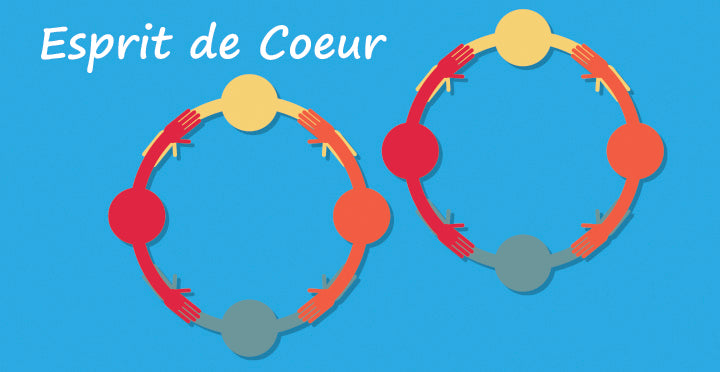
We have a lot to be thankful to France for... most of which is exported!
In the realm of hospitality we’re indebted to France for 2 concepts: Mise en Place and Esprit de Corps.
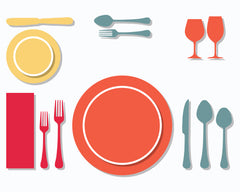 Most hospitality workers are familiar with Mise en Place, “everything in its place” as a methodology for bar, kitchen set-ups so that the right tools, spacing, products are within the right distance to the work performed.
Most hospitality workers are familiar with Mise en Place, “everything in its place” as a methodology for bar, kitchen set-ups so that the right tools, spacing, products are within the right distance to the work performed.
 Esprit de Corps: the common spirit existing in the members of a group inspiring enthusiasm, devotion, and strong regard for the honour of the group.
Esprit de Corps: the common spirit existing in the members of a group inspiring enthusiasm, devotion, and strong regard for the honour of the group.
A newer concept that should be equally at home within the hospitality world resting at the epicentre of the guest experience; we call it Esprit de Coeur.
Sitting at a new year’s degustation dinner waiting to bring in a new year... we were greeted by as many servers and specialists as there were courses to be had.
The cuisine was excellent, however depending on server, the energy level and enthusiasm of each person left a type of energy residue impacting the flavour of each course... noticeable increases in flavour seemed to occur when 2 staff in particular... the sommelier and one special server, were involved.
Whilst these 2 individuals acted separate to each... each had a natural enthusiasm, radiating from their hearts to their smiles, changing their body language as well as demeanour! There was the feeling that no amount of money could compensate these 2 pros for the total love of their craft and the guests they treat.
Being NYE what seemed even more remarkable, these two were not with their loved ones; making their enthusiasm extraordinary!
The natural desire of 2 hospitality professionals to radiate positivity, share knowledge, provide care without thinking… transformed a tremendous meal and occasion into a life changing experience.
So now let’s attempt at creating a definition for Esprit de Coeur...
Esprit de Coeur: a love affair of service and care emanating from an individual’s innermost desire is to help and serve others; transforming hospitality experiences into moments turned into occasion, irrespective of whether they are or not!
What do you think!
Innovate Or Perish... The Do or Die of a Bar
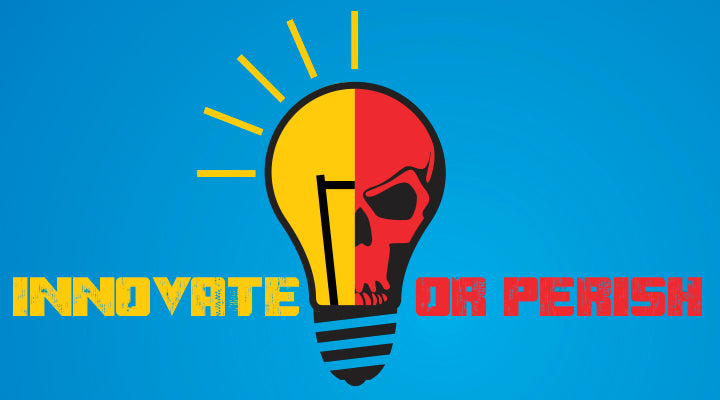
The old adage “a rolling stone gathers no moss” applies today to any bar and restaurant business.
The advice suggests: continuous movement or innovation keeps businesses nimble and responsive! Failure conversely; a perishable outcome!
Rolling stones require energy, lose momentum and one quickly finds oneself standing on the Titanic end of inaction, waiting for the orchestra to play your competitors new song!
Far too many bars find a niche, work it, and yet fail to tweak, refine and on occasion pivot due to management's false feeling of comfort and safety!
Competition, rapid change and instant learning translates desire into needs, a process of forward motion called “Kaizen”.
To canny business people, Innovation translates opportunity into profit (the new black) for liquid/hospitality entrepreneurs!
Today’s consumers have short attention spans, are easily confused and become unmoved!
New, intriguing, fresh become the new mind grabs oiling attention; winning action, attracting $!
Innovation or Perish!
 We’re not advocating for a moment that it’s only Innovation that’s the key to business success, it’s more about the back end process of developing at the margins, new ideas, tinkering with what’s successful now and how that will look with a fresh twist!
We’re not advocating for a moment that it’s only Innovation that’s the key to business success, it’s more about the back end process of developing at the margins, new ideas, tinkering with what’s successful now and how that will look with a fresh twist!
Helping customers translate their unsatisfied desires into new wants, allows us to engage and connect very differently with people.
Translated desires turn into new curated drinking experiences, ultimately keeping folks talking, happy; returning to your point of origin!
Warning: Innovation by and of itself is NOT a cure-all as innovation requires stewardship, focus and planning to ensure action, success and profitability!
 Innovation is the story of forward momentum, anything less, is turning a business into a perishable. Innovate or Perish!
Innovation is the story of forward momentum, anything less, is turning a business into a perishable. Innovate or Perish!
Today’s Innovator becomes tomorrows Perishable... better get moving!
Speak easy move fast.. Speed Behind the Bar
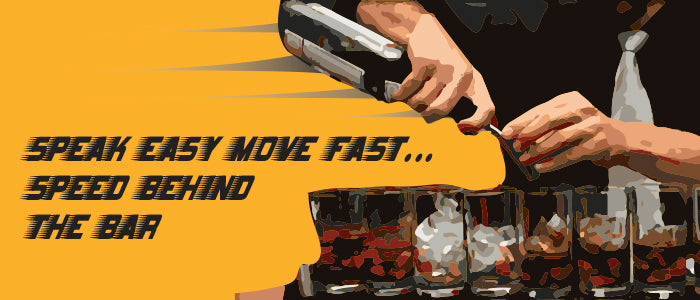
There’s been much debate amongst bartenders concerning the pros and cons of speed behind the bar.
Speak to any bartender working a club, Vegas Strip, high volume bar and they’ll quickly tell you speed‘s king!
If you’re working just for tips, as many do in the US, speedy drinks equals fast tips!
With many bartenders regarding themselves as guns... delays in making a drink is costly so, it’s all guns blazing or go hungry!
Like most traditions behind a bar, they didn’t happen overnight... they evolved over time.
On that basis, it’s possible that Prohibition era American Speak Easy bars are the likely modern starting point of the need for speed behind the bar! The rationale: Speak Easy owners/bartenders never knew when they could be raided by authorities… seems logical then, if you wanted to sell plenty of drinks, make money, that a heighted sense of urgency was required... speed was critical!
The rationale: Speak Easy owners/bartenders never knew when they could be raided by authorities… seems logical then, if you wanted to sell plenty of drinks, make money, that a heighted sense of urgency was required... speed was critical!
During Prohibition drink quality and craftsmanship were not deemed particularly important, so speed was the catalyst to drinking quick and serving fast!
Whilst at Uber we don’t agree that fast drinks will necessarily be good in terms of quality, flavour and balance, we realize there’s plenty of room to cater for all styles and sorts of bartending/customer needs.
Customers waiting to be served is money potentially left on the table; drinks poorly executed represent money leaving a venue as a guest potentially swaps to a cheaper drink category or leaves disappointed altogether!
Speed behind the bar has consequences... it comes down to juggling between speed, care and quality… pick any 2!
Spirits Chevalier Beyond Mixologist

French terms are entrenched in hospitality adding elegance and refinement to describe process and outcomes.
Once upon a time professional Bartenders struggled with an adequate descriptor to purpose their skills and talent.
To fill this void various self-ascribed terms were created and have now entered the bar lexicon including Mixologist, Liquid Chef, Cocktologist to name a few.
In a new age where a shingle can be quickly invented via a web site, Linked In profile or business card... it’s perhaps timely whereby spirits knowledge, mixing, serving experience, operational know-how and management skill could be better defined with an all-encompassing term with professional presence, prestige and yes panache!
Australians are a funny lot… we invent irreverent and quirky names for everything... some examples… fruit seller: a fruitologist, a trash or garbage collector: a garbologist... whilst in no way diminishing these professions think there’s still more room that elevates elite bartenders beyond the word Mixologist!

It’s not unknown for some bar rookies to imagine that attendance at a 1 day bar course, several spirits education event(s) together with a little bit of “stick” under the belt to be sufficient to self-describe as a Mixologist nee bartender... of course the more practical amongst us know it takes a lot more than spirits to maketh the bartender.
Back in Prohibition times and the generation before, bartending was considered not only a noble profession but a position with community respect; in a nut shell the word bartender meant something.
It takes years to acquire the necessary mastery to evolve past a generic descriptor such as bartender and in the process attain meritorious professional standing; with requisite recognition and compensation.
It’s time for a newer term to clearly position the professors of spirits from the doctors, interns and students of the mahogany!
 We propose a new term:
We propose a new term:
Spirits Chevalier, elevating the Mixologist to a higher standing equivalent or surpassing that associated with the term, Sommelier.
A Spirit Chevalier can only be earned not daubed like a fake Knighthood or regal title purchased from a defunct duchy, princedom or cash strapped state.
Great terms with honours must be accorded; requiring new levels of International standards so that those who have acquired and fulfilled all aspects can only then be elevated to become a Spirits Chevalier.
MixTake - Bartender Scapegoat

On the internet little is written on the topic of bartender scapegoating, this process we call a MixTake!
MixTakes represent alcohol discrepancies, waste and over-pouring (DWO) with Management only blaming bartenders!
Why the Mixtake?  Confusion exists between the concept of mixing a drink and DWO; both involve liquid transference; with one attached to blame!
Confusion exists between the concept of mixing a drink and DWO; both involve liquid transference; with one attached to blame!
MixTakes are generally caused by Management misunderstanding operational figures creating 2 victims; the bartender and team morale!
Many bar and beverage managers have never received professional training on the math, science and dynamics of running a bar, thereby making it easy to draw a straight line from the problem to a bartender!
On the other hand, professionals coming out of culinary institutions tend to have the benefit of being taught scientific process to problem solve.
Scapegoated bartenders tends to work in bars where there‘s little or no investment in proper pouring tools, allowing sloppiness to set in, with potential protective steps missed or overlooked.
In our view Management must provide the tools and training for bartenders to do the job expected, anything less, well, that’s a MixTake!
Scapegoating bartenders without equally apportioning responsibility to management is a massive MixTake, costing business opportunity and destroying careers!
More Pimples than Dimples

Success is not attractive when it’s just cosmetic.
In a hospitality marketplace with too many choices, being noticed is more important than looking pretty!
Great looking bars and restaurants dot the map yet rarely cross the “T(errific)” intersection or consumer crosshairs!
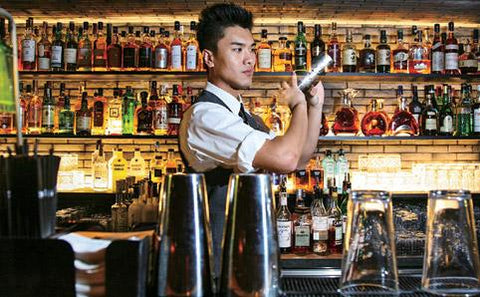
 In a world where more real, more authentic and more crafty is the badge of individuality and exception... “Pimples” work!
In a world where more real, more authentic and more crafty is the badge of individuality and exception... “Pimples” work!
 Of course, “Dimples” are the cute boy or girl next door look... but… why have what’s next door, when we can go out for fun and adventure elsewhere or everywhere!
Of course, “Dimples” are the cute boy or girl next door look... but… why have what’s next door, when we can go out for fun and adventure elsewhere or everywhere!
Hands up for being the only “Pimple” on the block: having excited guests coming back for more is what it’s all about!

